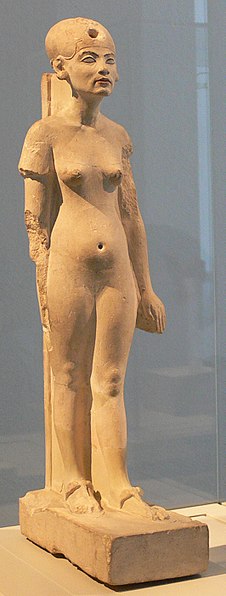The Nefertiti Bust is a painted stucco-coated limestone bust of Nefertiti, the Great Royal Wife of Egyptian pharaoh Akhenaten. It is on display in the Egyptian Museum of Berlin.
The iconic bust of Nefertiti is part of the Egyptian Museum of Berlin collection.
Nefertiti Bust
A "house altar" (c. 1350 BC) depicting Akhenaten, Nefertiti and three of their daughters. Nefertiti is shown wearing a crown similar to that depicted on the bust.
Nefertiti bust
Nefertiti was a queen of the 18th Dynasty of Ancient Egypt, the great royal wife of Pharaoh Akhenaten. Nefertiti and her husband were known for their radical overhaul of state religious policy, in which they promoted the earliest known form of monotheism, Atenism, centered on the sun disc and its direct connection to the royal household. With her husband, she reigned at what was arguably the wealthiest period of ancient Egyptian history. After her husband's death, some scholars believe that Nefertiti ruled briefly as the female king known by the throne name, Neferneferuaten and before the ascension of Tutankhamun, although this identification is a matter of ongoing debate. If Nefertiti did rule as Pharaoh, her reign was marked by the fall of Amarna and relocation of the capital back to the traditional city of Thebes.
The bust of Nefertiti from the Egyptian Museum of Berlin collection, presently in the Neues Museum
Alabaster sunken relief depicting Akhenaten, Nefertiti, and daughter Meritaten. Early Aten cartouches on king's arm and chest. From Amarna, Egypt. 18th Dynasty. The Petrie Museum of Egyptian Archaeology, London
A standing/striding figure of Nefertiti made of limestone. Originally from Amarna, part of the Ägyptisches Museum Berlin collection.
Nefertiti worshipping the Aten. She is given the title of Mistress of the Two Lands. On display at the Ashmolean Museum, Oxford.







